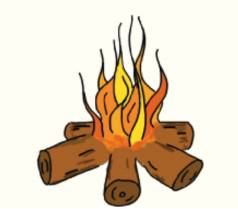
Conceptual Integrated Science
3rd Edition
ISBN: 9780135197394
Author: Hewitt, Paul G., LYONS, Suzanne, (science Teacher), Suchocki, John, Yeh, Jennifer (jennifer Jean)
Publisher: PEARSON EDUCATION (COLLEGE)
expand_more
expand_more
format_list_bulleted
Textbook Question
Chapter 13, Problem 60TE
Why does blowing into a campfire make the fire burn brighter?

Expert Solution & Answer
Want to see the full answer?
Check out a sample textbook solution
Students have asked these similar questions
Please don't use Chatgpt will upvote and give handwritten solution
how would i express force in vector form I keep getting a single number
please help me solve this questions. show all calculations and a good graph too :)
Chapter 13 Solutions
Conceptual Integrated Science
Ch. 13 - Prob. 1RCCCh. 13 - Prob. 2RCCCh. 13 - Prob. 3RCCCh. 13 - If it takes 436 kilojoules to break a bond, how...Ch. 13 - What is released by an exothermic reaction?Ch. 13 - What is absorbed by an endothermic reaction?Ch. 13 - Prob. 7RCCCh. 13 - What generally happens to the rate of a chemical...Ch. 13 - Which reactant molecules are the first to pass...Ch. 13 - How is an acid different from a base?
Ch. 13 - When an acid is dissolved in water, what ion does...Ch. 13 - Prob. 12RCCCh. 13 - Are there many hydronium ions in neutral water?Ch. 13 - What is true about the relative concentrations of...Ch. 13 - What does the pH of a solution indicate?Ch. 13 - Prob. 16RCCCh. 13 - What elements have the greatest tendency to behave...Ch. 13 - What happens to a reducing agent as it reduces?Ch. 13 - What metal coats a galvanized nail?Ch. 13 - What is iron forced to accept during cathodic...Ch. 13 - What happens to the polarity of oxygen atoms as...Ch. 13 - What catalyst is effective in the destruction of...Ch. 13 - Prob. 23TISCh. 13 - What net effect does a chemical reaction have on a...Ch. 13 - What is the product of the reaction between carbon...Ch. 13 - Prob. 26TISCh. 13 - Prob. 27TISCh. 13 - A material that tends to lose electrons is put...Ch. 13 - What is the primary difference between a battery...Ch. 13 - Prob. 30TISCh. 13 - Rank these reaction profiles in order of...Ch. 13 - Rank the covalent bonds in order of increasing...Ch. 13 - Review the concept of electronegativity in Section...Ch. 13 - Review the concept of electronegativity in Section...Ch. 13 - Rank these molecules from least oxidized to most...Ch. 13 - Prob. 44TSCh. 13 - Prob. 45TSCh. 13 - When the hydronium ion concentration of a solution...Ch. 13 - When the pH of a solution is 1, the concentration...Ch. 13 - Show that the pH of a solution is 0.301 when its...Ch. 13 - Show that the hydroxide ion concentration of a...Ch. 13 - How can 50g of wood burn to produce more than 50g...Ch. 13 - Balance these equations: a Fe(s)+O2(g)Fe2O3(s) b...Ch. 13 - Balance these equations: a Fe(s)+S(s)Fe2S3(s) b...Ch. 13 - Prob. 53TECh. 13 - Use the following illustration to answer exercises...Ch. 13 - Use the following illustration to answer exercises...Ch. 13 - What changes during a chemical reaction?Ch. 13 - Prob. 58TECh. 13 - Is photosynthesis an exothermic or endothermic...Ch. 13 - Why does blowing into a campfire make the fire...Ch. 13 - In the laboratory, endothermic reactions are...Ch. 13 - Prob. 62TECh. 13 - Why does a glowing splint of wood burn only slowly...Ch. 13 - Prob. 64TECh. 13 - Chew a salt-free soda cracker for a few minutes...Ch. 13 - Prob. 66TECh. 13 - Does the ozone pollution from automobiles help...Ch. 13 - Chlorine is put into the atmosphere by volcanoes...Ch. 13 - Prob. 69TECh. 13 - Prob. 70TECh. 13 - An acid and a base react to form salt, which...Ch. 13 - Identify the acid or base behavior of each...Ch. 13 - Prob. 73TECh. 13 - Prob. 74TECh. 13 - The main component of bleach is sodium...Ch. 13 - Prob. 76TECh. 13 - Prob. 77TECh. 13 - Within a neutral solution of supercritical water...Ch. 13 - What is the concentration of hydronium ions in a...Ch. 13 - Can an acidic solution be made less acidic by...Ch. 13 - How does burning fossil fuels lower the pH of the...Ch. 13 - Bubbling carbon dioxide into water causes the pH...Ch. 13 - Pour vinegar onto beach sand from the Caribbean,...Ch. 13 - What happens to the pH of soda water as it loses...Ch. 13 - Prob. 85TECh. 13 - Prob. 86TECh. 13 - Why is the chlorine atom such a strong oxidizing...Ch. 13 - Prob. 88TECh. 13 - What element behaves as the oxidizing agent in the...Ch. 13 - Hydrogen sulfide, H2S, burns in the presence of...Ch. 13 - Unsaturated fatty acids, such as C12H22O2, react...Ch. 13 - The type of iron that the human body needs for...Ch. 13 - Why is lithium a preferred metal for the making of...Ch. 13 - Chemical equations must be balanced not only in...Ch. 13 - Study question 94 before attempting to balance...Ch. 13 - How does turning on the radio while you are...Ch. 13 - What are some key advantages that a fuel-cell...Ch. 13 - Do our bodies gradually oxidize or reduce the food...Ch. 13 - Pennies manufactured after 1982 are made of zinc...Ch. 13 - Water is 88.88 oxygen by mass. Oxygen is exactly...Ch. 13 - Why is the air over an open flame always moist?Ch. 13 - Upon ingestion, grain alcohol, C2H6O, is...Ch. 13 - Prob. 103TDICh. 13 - Can industries be trusted to self-regulate the...Ch. 13 - In the centralized model for generating...Ch. 13 - Prob. 1RATCh. 13 - Prob. 2RATCh. 13 - How much energy, in kilojoules, is released or...Ch. 13 - The yeast in bread dough feeds on sugar to produce...Ch. 13 - What role do CFCs play in the catalytic...Ch. 13 - What is the relationship between the hydroxide ion...Ch. 13 - When the hydronium ion concentration equals 1 mole...Ch. 13 - Prob. 8RATCh. 13 - Why does a battery that has thick zinc walls last...Ch. 13 - What element is oxidized in this equation and what...
Additional Science Textbook Solutions
Find more solutions based on key concepts
How do food chains and food webs differ? Which is the more accurate representation of feeding relationships in ...
Biology: Life on Earth with Physiology (11th Edition)
48. Are these data sets on chemical changes consistent with the law of conservation of mass?
a. A 12.8-g sample...
Introductory Chemistry (6th Edition)
16. Your 1000-m-long starship has warning lights at each end that, to you, flash simultaneously every minute. Y...
College Physics: A Strategic Approach (3rd Edition)
WHAT IF? Suppose two plant populations exchange pollen and seeds. In one population, individuals of genotype AA...
Campbell Biology in Focus (2nd Edition)
How do you think a cell performing cellular respiration rids itself of the resulting CO2?
Campbell Biology (11th Edition)
Two culture media were inoculated with four different bacteria. After incubation, the following results were ob...
Microbiology: An Introduction
Knowledge Booster
Learn more about
Need a deep-dive on the concept behind this application? Look no further. Learn more about this topic, physics and related others by exploring similar questions and additional content below.Similar questions
- What is the force (in N) on the 2.0 μC charge placed at the center of the square shown below? (Express your answer in vector form.) 5.0 με 4.0 με 2.0 με + 1.0 m 1.0 m -40 με 2.0 μCarrow_forwardWhat is the force (in N) on the 5.4 µC charge shown below? (Express your answer in vector form.) −3.1 µC5.4 µC9.2 µC6.4 µCarrow_forwardAn ideal gas in a sealed container starts out at a pressure of 8900 N/m2 and a volume of 5.7 m3. If the gas expands to a volume of 6.3 m3 while the pressure is held constant (still at 8900 N/m2), how much work is done by the gas? Give your answer as the number of Joules.arrow_forward
- The outside temperature is 25 °C. A heat engine operates in the environment (Tc = 25 °C) at 50% efficiency. How hot does it need to get the high temperature up to in Celsius?arrow_forwardGas is compressed in a cylinder creating 31 Joules of work on the gas during the isothermal process. How much heat flows from the gas into the cylinder in Joules?arrow_forwardThe heat engine gives 1100 Joules of energy of high temperature from the burning gasoline by exhausting 750 Joules to low-temperature . What is the efficiency of this heat engine in a percentage?arrow_forward
- L₁ D₁ L₂ D2 Aluminum has a resistivity of p = 2.65 × 10 8 2. m. An aluminum wire is L = 2.00 m long and has a circular cross section that is not constant. The diameter of the wire is D₁ = 0.17 mm for a length of L₁ = 0.500 m and a diameter of D2 = 0.24 mm for the rest of the length. a) What is the resistance of this wire? R = Hint A potential difference of AV = 1.40 V is applied across the wire. b) What is the magnitude of the current density in the thin part of the wire? Hint J1 = c) What is the magnitude of the current density in the thick part of the wire? J₂ = d) What is the magnitude of the electric field in the thin part of the wire? E1 = Hint e) What is the magnitude of the electric field in the thick part of the wire? E2 =arrow_forwardplease helparrow_forwardA cheetah spots a gazelle in the distance and begins to sprint from rest, accelerating uniformly at a rate of 8.00 m/s^2 for 5 seconds. After 5 seconds, the cheetah sees that the gazelle has escaped to safety, so it begins to decelerate uniformly at 6.00 m/s^2 until it comes to a stop.arrow_forward
- A projectile is fired with an initial speed of 40.2 m/s at an angle of 35.0 degree above the horizontal on a long flat firing range. Determine. please help and show work for them so i can understand.arrow_forwardpls helparrow_forwardJ K L The graph in the figure shows the position of an object as a function of time. The letters H-L represent particular moments of time. At which moments shown (H, I, etc.) is the speed of the object the greatest? + Position H I K Timearrow_forward
arrow_back_ios
SEE MORE QUESTIONS
arrow_forward_ios
Recommended textbooks for you
 An Introduction to Physical SciencePhysicsISBN:9781305079137Author:James Shipman, Jerry D. Wilson, Charles A. Higgins, Omar TorresPublisher:Cengage Learning
An Introduction to Physical SciencePhysicsISBN:9781305079137Author:James Shipman, Jerry D. Wilson, Charles A. Higgins, Omar TorresPublisher:Cengage Learning Principles of Physics: A Calculus-Based TextPhysicsISBN:9781133104261Author:Raymond A. Serway, John W. JewettPublisher:Cengage Learning
Principles of Physics: A Calculus-Based TextPhysicsISBN:9781133104261Author:Raymond A. Serway, John W. JewettPublisher:Cengage Learning Glencoe Physics: Principles and Problems, Student...PhysicsISBN:9780078807213Author:Paul W. ZitzewitzPublisher:Glencoe/McGraw-Hill
Glencoe Physics: Principles and Problems, Student...PhysicsISBN:9780078807213Author:Paul W. ZitzewitzPublisher:Glencoe/McGraw-Hill Physics for Scientists and Engineers, Technology ...PhysicsISBN:9781305116399Author:Raymond A. Serway, John W. JewettPublisher:Cengage Learning
Physics for Scientists and Engineers, Technology ...PhysicsISBN:9781305116399Author:Raymond A. Serway, John W. JewettPublisher:Cengage Learning University Physics Volume 3PhysicsISBN:9781938168185Author:William Moebs, Jeff SannyPublisher:OpenStax
University Physics Volume 3PhysicsISBN:9781938168185Author:William Moebs, Jeff SannyPublisher:OpenStax Physics for Scientists and Engineers: Foundations...PhysicsISBN:9781133939146Author:Katz, Debora M.Publisher:Cengage Learning
Physics for Scientists and Engineers: Foundations...PhysicsISBN:9781133939146Author:Katz, Debora M.Publisher:Cengage Learning

An Introduction to Physical Science
Physics
ISBN:9781305079137
Author:James Shipman, Jerry D. Wilson, Charles A. Higgins, Omar Torres
Publisher:Cengage Learning

Principles of Physics: A Calculus-Based Text
Physics
ISBN:9781133104261
Author:Raymond A. Serway, John W. Jewett
Publisher:Cengage Learning

Glencoe Physics: Principles and Problems, Student...
Physics
ISBN:9780078807213
Author:Paul W. Zitzewitz
Publisher:Glencoe/McGraw-Hill

Physics for Scientists and Engineers, Technology ...
Physics
ISBN:9781305116399
Author:Raymond A. Serway, John W. Jewett
Publisher:Cengage Learning

University Physics Volume 3
Physics
ISBN:9781938168185
Author:William Moebs, Jeff Sanny
Publisher:OpenStax

Physics for Scientists and Engineers: Foundations...
Physics
ISBN:9781133939146
Author:Katz, Debora M.
Publisher:Cengage Learning
The Laws of Thermodynamics, Entropy, and Gibbs Free Energy; Author: Professor Dave Explains;https://www.youtube.com/watch?v=8N1BxHgsoOw;License: Standard YouTube License, CC-BY